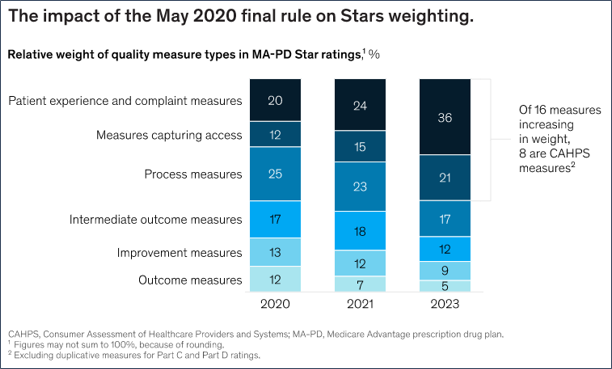Providing excellent customer experience has become a critical factor for remaining competitive in most industries. Yet health insurance organizations have not been as successful in improving member experience as their counterparts in other industries. Private Medicare Advantage (MA) insurance providers are a prime example. Medicare Advantage plan insurers provide one plan for all the services covered under the 3 separate parts of original Medicare (Part A, Hospital Insurance; Part B, Medical/Outpatient/Physician Insurance; and Part D, Medication/Drug Insurance) for Medicare beneficiaries who choose to opt-out of traditional Medicare. However, many MA plan providers lack the tools necessary to monitor all customer-facing departments and to get to the root causes of poor member experience; as a result, member loyalty is waning.
Medicare Advantage Plans
Because the Centers for Medicare & Medicaid Services (CMS) finances the premiums paid to private MA plans on behalf of Medicare beneficiaries, they use a five‐star quality rating system to measure and monitor the quality of care received and beneficiaries’ experiences with their private health plans and the health care system. MA Plans are rated on a one-to-five scale, with one star representing poor performance and five stars representing excellent performance. Star ratings are released annually to allow Medicare beneficiaries to compare MA plans and make informed decisions. CMS also uses the Star ratings to provide incentives to MA plans, including unlimited, year-round enrollment, as well as financial bonuses for 5 Star plans. However, despite the success of the Stars program in driving improved MA plan quality metric scores, e.g., the percent of members receiving cancer screenings, the program has been less successful in improving members’ reported experience of care metrics, e.g., getting appointments and care quickly. Improvements are needed to ensure seniors get the exceptional health care experience they deserve and, consequently, remain loyal to their Medicare insurance providers.
Calculating Medicare Advantage Stars Quality Scores
CMS recently elevated the role of member experience metrics in evaluating MA plan quality and, in May of 2020, changed the methodology for how they calculate Stars scores. As a result, patient/member experience-related metrics now carry more weight and will account for 57% of Star ratings by 2023, an increase of 25 percentage points since 2020. Excellent patient/member experiences are now more critical than ever because they ensure Stars-linked incentives and potentially drive plan growth. Medicare insurance plans must now provide exceptional member/patient experiences at all customer touchpoints to drive improved patient-reported experience metrics and overall Star ratings. It is imperative for MA plans to improve patient experience, to maintain or grow revenues and market share.
Source: McKinsey & Company, New Stars ratings for Medicare Advantage prioritize customer experiences, 2020.
Improving Reported Experiences of Health Care
Insurers need to adopt a data-driven analytical approach to move the needle on patient/member experience to maintain as well as improve their Star metrics and maximize their bonus payments, as well as maintain and grow market share. With the right methodology in place, data analytics can be leveraged to create improvements in the patient experience at every touchpoint in the health care system. Ideally, such approaches should include root cause assessments, process efficiencies, Stars dashboarding and analytics, patient/member journey mapping, Voice of the Customer (VOC) insights through quality monitoring and surveying, as well as employee training.
Leveraging Data Analytics Insights to Improve Member Experience
Fortunately, there are numerous methods and tools available that insurers can use to listen to the Voice of the Customer (VOC) including leveraging quality monitoring to obtain VOC insights and then analyzing the feedback to make the process and behavioral improvements that drive member experience. For example, a Fortune 100 healthcare enterprise that Northridge worked with needed to identify and address patient/member pain points and create new, innovative processes to create marketplace differentiation. Using VOC insights and an end-to-end view of the patient/member journey, Northridge redesigned the client’s customer service model to deliver more effective, personalized interactions and proactive solutions during Moments of Truth (the points in a customer journey when a key event occurs and an opinion about the brand is formed). We then developed an operational model and pilot program that included new metrics, redefined quality standards and introduced cultural changes to reinforce and recognize the desired experience. Our analysis yielded the following results for our client:
- Development of service blueprints for all business segments, providing a view of the patient/member lifecycle and areas of potential differentiation
- Identification of a roadmap of high-impact, cross-functional redesign efforts to accelerate their progress toward the desired future-state
- A re-engineering of their quality program and metrics to create new standards of patient/member service excellence
- Development of a pilot program to train the team on new processes to reduce complexities for patients/members
Investing in Member Experience Must Become a Priority
Improving member experience is not only good for business, achieving this goal offers financial incentives for insurers as well. A recent customer survey found that satisfied members are five times more likely to renew their health insurance coverage than their unsatisfied peers.
The new emphasis on patient/member experience in CMS’s revised Stars methodology makes member experience performance an imperative for MA carriers. To achieve high Star ratings, drive growth and increase the share of the Medicare age-in population enrolling in their MA plans, insurers need to prioritize investments in member experience. Investments such as improvements in operations and the increased use of predictive analytics to personalize engagement with members not only improve Stars performance and health plan economics but also provide a way to improve member loyalty and retention in a complex and often frustrating healthcare system at a time when healthcare has never mattered more.
When it comes to your organization’s patient/member experience, there is a lot on the line. To find out how Northridge’s industry-leading Customer Experience and Contact Center Management expertise can help determine the specific pain points impacting your Star ratings and help improve the patient/member experience at your healthcare organization, contact us.





